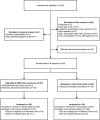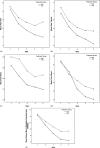A randomized, controlled trial of osteopathic manipulative treatment for acute low back pain in active duty military personnel
- PMID: 23372389
- PMCID: PMC3267441
- DOI: 10.1179/2042618611Y.0000000016
A randomized, controlled trial of osteopathic manipulative treatment for acute low back pain in active duty military personnel
Abstract
Objective: Acute low back pain (ALBP) may limit mobility and impose functional limitations in active duty military personnel. Although some manual therapies have been reported effective for ALBP in military personnel, there have been no published randomized controlled trials (RCTs) of osteopathic manipulative treatment (OMT) in the military. Furthermore, current military ALBP guidelines do not specifically include OMT.
Methods: This RCT examined the efficacy of OMT in relieving ALBP and improving functioning in military personnel at Fort Lewis, Washington. Sixty-three male and female soldiers ages 18 to 35 were randomly assigned to a group receiving OMT plus usual care or a group receiving usual care only (UCO).
Results: The primary outcome measures were pain on the quadruple visual analog scale, and functioning on the Roland Morris Disability Questionnaire. Outcomes were measured immediately preceding each of four treatment sessions and at four weeks post-trial. Intention to treat analysis found significantly greater post-trial improvement in 'Pain Now' for OMT compared to UCO (P = 0·026). Furthermore, the OMT group reported less 'Pain Now' and 'Pain Typical' at all visits (P = 0·025 and P = 0·020 respectively). Osteopathic manipulative treatment subjects also tended to achieve a clinically meaningful improvement from baseline on 'Pain at Best' sooner than the UCO subjects. With similar baseline expectations, OMT subjects reported significantly greater satisfaction with treatment and overall self-reported improvement (P<0·01).
Conclusion: This study supports the effectiveness of OMT in reducing ALBP pain in active duty military personnel.
Keywords: Low back pain; Manipulation; Manual medicine.
Figures




References
-
- Cohen SP, Nguyen C, Kapoor SG, Anderson-Barnes VC, Foster L, Shields C, et al. Back pain during war: an analysis of factors affecting outcome. Arch Intern Med 2009;20:1916–23 - PubMed
-
- Knapik JJ, Jones SB, Darakjy S, Hauret KG, Bullock SH, Sharp MA, et al. Injury rates and injury risk factors among U.S. Army wheel vehicle mechanics. Mil Med 2007;9:988–96 - PubMed
-
- Jonas WB, O’Connor F, Deuster P, Macedonia C. Total force fitness for the 21st Century: a new paradigm. Mil Med; 2010;175;1–78
-
- Cohen SP, Griffith S, Larkin TM, Villena F, Larkin R. Presentation, diagnoses, mechanisms of injury, and treatment of soldiers injured in Operation Iraqi Freedom: an epidemiological study conducted at two military pain management centers. Anesth Analg 2005;4:1098–103 - PubMed
LinkOut - more resources
Full Text Sources
Research Materials
